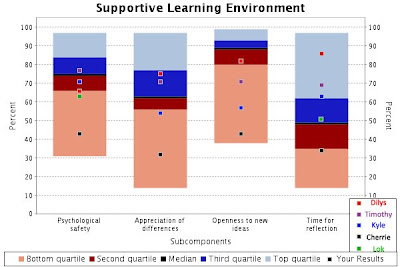Dilys' Unit
Kyle's Unit
Cherrie's Unit
Combined Learning Organisation Survey


Chart 2 Result Comment

Chart 3 Result Comment
Work done by all group members: Lok, Dilys, Kyle, Cherrie, Timothy
Dilys' Unit
Kyle's Unit
Cherrie's Unit
Combined Learning Organisation Survey



1. Moral Purpose
Moral purpose means closing the gap between high performing schools and lower performing schools; high performing and lower performing students, by raising the level of achievement of all. So, school principal needs to concern about the success of other schools in the district as he is about his own school.
For the case we shared in the previous post.
Mr. C has done well on closing the gap between district school, and even outside HK. He encourages teachers to learn the new initiatives and curriculum through interflow to the Education Bureau, inter/intra-school sharing amongst teachers, and also sharing with “super-teachers” from China. All these help bring the successful among schools.
2. Essential for leaders to understand the change process
A good leader should have positive attitude to face difficulties of trying something new and redefine resistance as a potential positive force. And never made a checklist during the process, always be complexity and flexibility.
Mr. C advocates extensive use of IT in education through intranet, internet and e-books as he considers IT a very effective tool which can facilitate learning and teaching. Although some teachers are not adopted to the changes and may cause resistance, but Mr. C have provided teachers training and equipped them with the knowledge and skills in IT in Education.
3. Building good relationships
Effective leaders constantly foster purposeful interaction and problem solving, and are wary of easy consensus. Also, emotional intelligence is a must for good leader to promote new ideas and collect feedbacks from different people.
Mr. C is a principal with good social connection and technological mind; he has initiated the use of video conferencing to conduct debates in English with a prestige school in Malaysia. So , a good relationship with staffs and even people in different area is important to progress new activities.
4. Generating and increasing knowledge inside and outside the organization
Principle must help to build up a environment that can let people easily to speak up, because people will not voluntarily share knowledge unless they feel some moral commitment to do so. Knowledge created must be shared with others, so good leaders therefore accept a degree of ambiguity but they also seek coherence.
Mr. C suggested extending the library opening time and alumni are being invited to be voluntary helpers of the library. Apart from helping in the regular book borrowing and returning matters, the helpers also play the role as tutors. This help the knowledge sharing well, and students are also welling to reflect their needs to school.
5. Coherence making values patterns worth retaining
Principals not attuned to leading in a culture of change make the mistake of seeking external innovations, and taking on too many projects. Leaders need “energy, enthusiasm and hopefulness” to help make people “feel that even difficult problems can be tackled productively”
